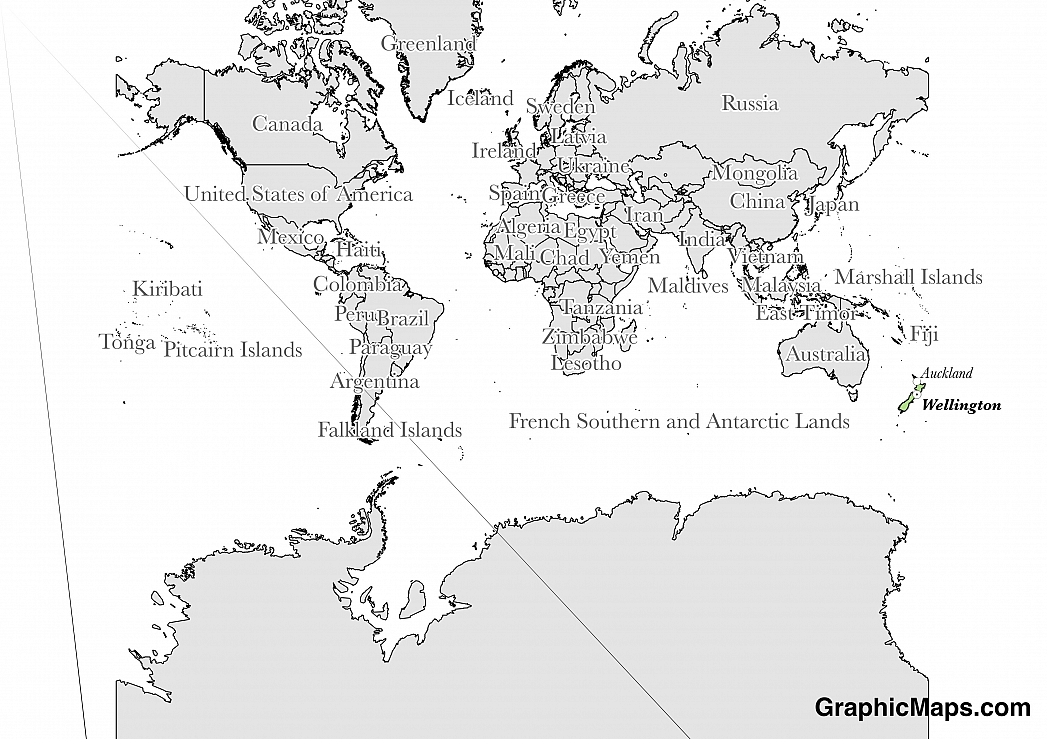Where is New Zealand?
Located in Oceania, New Zealand is an island nation. It has a 15,134.00 km coastline. New Zealand asserts a territorial claim in Antarctica called Ross Dependency.
The capital city of New Zealand is Wellington, which is located in the southern part of the North Island of the country. Wellington became the capital city of the country in 1865, replacing Auckland. Wellington's climate is classified as a temperate marine environment which sees modest temperatures year-round. The city is known for being windy all year as well as having a high frequency of rainfall. The town was settled by Europeans in 1839, but the city and surrounding areas had been occupied for centuries by the Maori people. The city is the political center of the country as well as housing several film studios, museums, and foreign embassies. The population of Wellington city is 203,000 but the surrounding areas that encompass the region is home to more than 412,000 residents. Wellington is made up of four towns, Lower and Upper Hutt, Porirua, and Wellington City.
Read more on New Zealand's CapitalNew Zealand is an Oceanian country covering 268,838.00 km2 of which 1.60% is water and 264,537.00 km2 is land. The area includes Antipodes Islands, Auckland Islands, Bounty Islands, Campbell Island, Chatham Islands, and Kermadec Islands. This makes it the 75th largest country in the world and almost twice the size of North Carolina; about the size of Colorado. Its geographic coordinates are 41 00 S, 174 00 E and Wellington is the capital city.
New Zealand was named Nova Zeeland by Dutch explorers.
Its ISO code is NZ.
Geography
New Zealand has a mean elevation of 388 m above sea level.
it has a temperate climate that varies greatly by region. Its terrain is predominately mountainous with some large coastal plains.
Population
New Zealand has a population of 4,474,549 making it the 126th largest in the world.
English is the de facto official language. The major ethnic group reported is European. The majority of the country is Christian or non-religious.
The official languages of New Zealand are Maori and New Zealand Sign Language but the most prevalent and de facto language of New Zealand is English with most, if not all, citizens speaking it as a first or second language. Approximately 96 percent of the population of New Zealand speaks English as their first language, and 3.7 percent speak Maori as a first language. Roughly 19 percent of the population of New Zealand is considered bi-lingual, and this number continues to climb. New Zealand English is regarded as one of the newest native English dialects and has developed into a uniquely accented language for the past 150 years. Minority languages in the country include Samoan, Hindi, Mandarin Chinese, French, and Yue Chinese. The Maori language has had a substantial influence on place names and names of flora and fauna in New Zealand and is often interwoven with New Zealand English.
Read more on New Zealand's LanguagesThe dialing code for the country is 64.
Government
New Zealand is an independent country. It gained independence from the United Kindom in 1907. Its constitution was last ratified in 1852.
The political system of New Zealand can be described as a representative parliamentary democracy. The legislative branch of government in New Zealand is based on precedents set by the United Kingdom's Westminster. The parliament of New Zealand is located in the capital of Wellington in the North Island of the country. There are 120 seats in the parliament of New Zealand made up of 71 electorate seats, decided by regional representation, and 49 list seats. The list seats are elected by the proportion of party votes that any one party receives. Elections in New Zealand take place every three years.
Read more on New Zealand's GovernmentEconomy
Factoring in Purchasing Power Parity, New Zealand's GDP is $175,000,000,000.00 (USD) with $37,100.00 (USD) per capita. This makes it the 67th largest economy and its citizens the 47th richest in the world. The currency of New Zealand is the Dollar (NZD).
Its major export partners are China, Australia, and the United States. Its main exports are dairy products, meat and edible offal, logs and wood articles. Its major import partners are China, Australia, and the United States. Its major imports include petroleum and products, mechanical machinery, and vehicles.
Flag
The flag of New Zealand consists of a blue field, a Union Flag on the mast side, and four red stars with white borders on the right-hand side. The current flag of New Zealand was designed by a First Lieutenant of the Royal Navy, Albert Hastings Markham, in 1869. The present flag was first used when it was flown on colonial ships based in the country during 1869 and was given official recognition as the national flag in 1902. The four red stars with white borders are representative of the nation's location in the Southern Pacific Ocean and also represent one of the most prominent constellations seen from the country. The Union Jack is a symbol of the country's British colonial past. Previous flags of New Zealand include the flag of the United Tribes of New Zealand, The Union Jack, and similar designs to the current flag which were used for the navy.
Read more on New Zealand's FlagThis page was last modified on January 17th, 2018
More on Graphicmaps

Published on 2019-11-06
What is a Trade Embargo?

Published on 2019-11-04
Which Two Countries Used to Have the Same Flag?

Published on 2019-09-16
What Is the Only Two-Sided State Flag?

Published on 2019-09-16
Which Country Flag Looks Like the Texas Flag?

Published on 2019-08-29
Flags That Resemble the US Flag

Published on 2019-08-20
